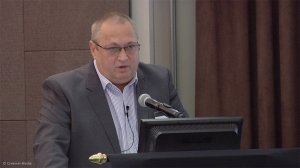JOHANNESBURG (miningweekly.com) – Gold miner Sibanye Gold plans to build a R3-billion, 150 MW solar power plant to ease its reliance on the costly and unreliable electricity supply from South Africa’s State-owned power utility Eskom, which posed a threat to the company’s current operations and future development.
Despite reducing electricity consumption by around 20% since 2007, Sibanye’s electricity costs had rapidly mounted, accounting for 9%, or R757-million, of its operating costs eight years ago and 20% currently, representing a potential bill of about R3.1-billion in 2015.
According to Sibanye, electricity had cost the company about R2.8-billion in 2014.
With labour costs accounting for another 55%, this meant that 75% of the gold miner’s operating costs were beyond its control.
“This is not a good place to be,” Sibanye CEO Neal Froneman said at the company’s year-end financial results presentation, in Sandton, on Thursday.
Further, load shedding had a significant impact on operations – a situation that was not likely to change as Eskom battled higher demand against critical power shortages.
“To mitigate the short-term risk, we have continued to work with Eskom to manage and reduce the impact of load shedding on our operations,” he explained, adding that it was clear, however, that the security of electricity supply and rising costs would remain an issue.
The modular power plant, expected to come online, possibly in phased 50 MW stages, at a site near Driefontein in 2017, would remove 10% of the company’s average daily energy requirements from the national grid.
Froneman advised that the permitting process for the plant was under way, with the required applications set to be submitted early in 2015, while funding options were being examined with banks and with potential partners for a possible offtake agreement. However, Sibanye had the funds to undertake the project, should it need to be self-funded.
While the 150 MW plant would meet only a portion of the company’s 500 MW demand, it was just the start, as Sibanye undertook an in-depth investigation into the feasibility of coal-fired power stations between 200 MW and 600 MW.
The group, which had been investigating alternative sources for long-term electricity supply for the past 18 months, was also engaging various independent power producers to develop “deeper insight” independent power generation.
While Sibanye noted in its year-end financial results report on Thursday that it intended to become fully independent of the national grid, Froneman told Mining Weekly Online that he was not sure this ambition would be entirely possible at this stage.
EMAIL THIS ARTICLE SAVE THIS ARTICLE
To subscribe email subscriptions@creamermedia.co.za or click here
To advertise email advertising@creamermedia.co.za or click here










